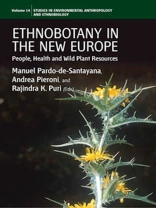The study of European wild food plants and herbal medicines is an old discipline that has been invigorated by a new generation of researchers pursuing ethnobotanical studies in fresh contexts. Modern botanical and medical science itself was built on studies of Medieval Europeans’ use of food plants and medicinal herbs. In spite of monumental changes introduced in the Age of Discovery and Mercantile Capitalism, some communities, often of immigrants in foreign lands, continue to hold on to old recipes and traditions, while others have adopted and enculturated exotic plants and remedies into their diets and pharmacopoeia in new and creative ways. Now in the 21st century, in the age of the European Union and Globalization, European folk botany is once again dynamically responding to changing cultural, economic, and political contexts. The authors and studies presented in this book reflect work being conducted across Europe’s many regions. They tell the story of the on-going evolution of human-plant relations in one of the most bioculturally dynamic places on the planet, and explore new approaches that link the re-evaluation of plant-based cultural heritage with the conservation and use of biocultural diversity.
Tabla de materias
List of Figures
List of Tables
List of Appendixes
Chapter 1. The Ethnobotany of Europe, Past and Present
Manuel Pardo-de-Santayana, Andrea Pieroni and Rajindra K. Puri
Chapter 2. People and Plants in Lëpushë: Traditional Medicine, Local Foods and Post-communism in a Northern Albanian Village
Andrea Pieroni
Chapter 3. The Cultural Significance of Wild-gathered Plant Species in Kartitsch (Eastern Tyrol, Austria) and the Influence of Socioeconomic Changes on Local Gathering Practices
Anja Christanell, Brigitte Vogl-Lukasser, Christian R. Vogl and Marianne Gütler
Chapter 4. Local Innovations to Folk Medical Conditions: Two Major Phytotherapeutic Treatments from the Maltese Islands
Timothy J. Tabone
Chapter 5. Local Awareness of Scarcity and Endangerment of Medicinal Plants in Roussenski Lom Natural Park in Northern Bulgaria
Hugo J. de Boer
Chapter 6. ‘My Doctor Doesn’t Understand Why I Use Them’: Herbal and Food Medicines amongst the Bangladeshi Community in West Yorkshire, U.K.
Andrea Pieroni, Hadar Zaman, Shamila Ayub and Bren Torry
Chapter 7. Persistence of Wild Food and Wild Medicinal Plant Knowledge in a Northeastern Region of Portugal
Ana Maria Carvalho and Ramón Morales
Chapter 8. The Use of Wild Edible Plants in the Graecanic Area in Calabria, Southern Italy
Sabine Nebel and Michael Heinrich
Chapter 9. The Ecology and Use of Edible Thistles in Évora, Alentejo, Southeastern Portugal
Maria José Barão and Alexandra Soveral Dias
Chapter 10. Spring is Coming: The Gathering and Consumption of Wild Vegetables in Spain
Javier Tardío
Chapter 11. Plants as Symbols in Scotland Today
Veerle Van den Eynden
Chapter 12. The Botanical Identity and Cultural Significance of Lithuanian Jovaras: An Ethnobotanical Riddle
Daiva Šeškauskaite and Bernd Gliwa
Chapter 13. Norway’s Rosmarin(Rhododendron tomentosum) in Past and Present Tradition
Torbjørn Alm and Marianne Iversen
Chapter 14. Chamomiles in Spain: The Dynamics of Plant Nomenclature
Manuel Pardo-de-Santayana and Ramón Morales
Chapter 15. A Preliminary Study of the Plant Knowledge and Grassland Management Practices of English Livestock Farmers, with Implications for Grassland Conservation
Jenny L. Mc Cune
Chapter 16. A Comparative Study of Rural and Urban Allotments in Gravesham, Kent, U.K.
Christine Wildhaber
Notes on Contributors
Index
Sobre el autor
Rajindra K. Puri is a Senior Lecturer in environmental anthropology and ethnobiology at the University of Kent at Canterbury, UK. While his primary research area is Indonesian Borneo, he also supervises M.Sc. and Ph.D. students who conduct ethnobotanical research in Europe. With Christian Vogl he co-organizes a summer field school in the Austrian Alps on methods in ethnobotany and works with the Global Diversity Foundation in Morocco, Malaysia and Namibia.












